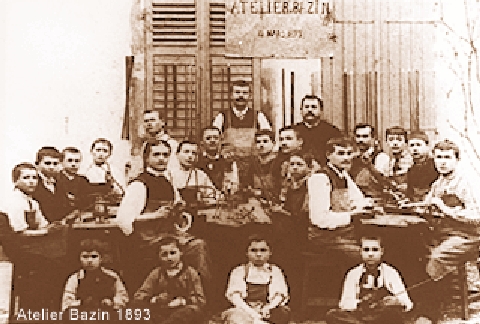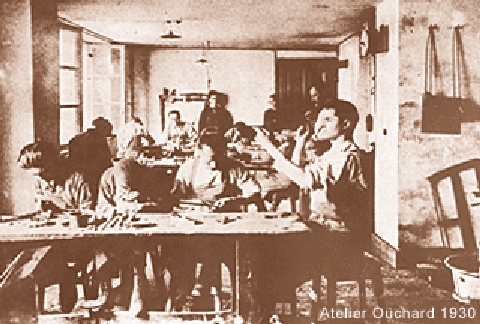THE BOWMAKERS' FACTORY
If, from one side, the story of modern bowmaking was written by few enlightened one, on the other side it was made by many fledgelings willing ones, as you can see.

Bazin's Workshop
To understand the evolution of French bowmaking, you need to know how the productive line of bows was structured. As we said, in Paris there were Tourte and Persoit who built high leveled bows, but their production was still not able to meet the needs of many musicians. And besides, like Stradivari, their bows were expensive and not everyone could afford one.
Unlike the Italian violin making, which did so only in recent times and for this reason by mid-nineteenth century in Cremona not even a shop remained open, the bow making has been able to develop not a school, but a real forge: Mirecourt.
Bazin's workshop is a classic example. As you can see, there are more than twenty people depicted in the photo, ranging from five to twenty years, apart the owners. You entered the laboratory at seven or eight years and started to become familiar with the work beginning from the simplest jobs as choosing the hair or classify the mother of pearl. After fifteen years of apprenticeship, if you had talent you could leave for Paris, hoping to get a work in an important workshop, this is the case of Jules Fetique, the boy with the mustache and an absurd haircut sitting in the foreground on the left, one year after this photo he went to work by Sartory. Or as his brother Victor, seated on the right, that moved to Paris as well to work in the Caressa and Francais' studio. To the other ones , it remained a job with which they could live and feed their children.
These were real factories in continuous production. Think that in a village of just over five thousand inhabitants, as was Mirecourt at the beginning of the twentieth century, the alliedcompaniesof violin and bow making gave work to over thousand people. Speaking with Pierre Guillaume, one of the latest craftsmen trained in this way, he told me that in the workshop where he worked , a huge quantity of bows were built, we speak about something like one hundred and fifty a week. Of course such a big a production doesn't give the possibility of treating the product very deeply, but it was not important, because the bows were cheap and furthermore they were useful to develop the hands of future masters.
I have to add that in my own career I have met good hands totallyin lackof the brain. Until the hands are guided by a good builder who understands the work and claims that he wants to run it in a proper way as Bazin Morizot, you can get a good average level. But when these same hands start an independent job, very often their quality of work fell relentlessly. For this reason we appreciate the work of these forges, unable to produce the absolute level, but still able to provide decent bows to everybody.
Not every workshops in Mirecourt were intensive production factories, there was also a parallel line. Another character among the most important of our world, Etienne Pajeot, had set up its own production, as his Parisian colleague: Vuillaume. Knowing deeply the job, he selected the best craftsmen and made them work accordingly to its directives. Think what the bow making world would have been if these two had not existed. For them worked almost all the great artisans of this discipline, perhaps we would not have known: Maire, Persoit, Maline, Voirin, Peccatte (whole family), Fonclouse, etc. ..
In any case , Mirecourt is a centerpiece of French violin and bow making. It is enough to say that all the French bowmakers, with the exception of Tourte and Persoit , were born and gave the first shots of plane in this town, and without it there would not have been so many good bow makers. Also because having one person out of five in bow making , most of the times it went as in the case of Cuniot, who had in his workshop a promising youngster named Hury and a daughter of marriageable age. One plus one is always two and in fact the workshop of the poor Cuniot, was transformed into Cuniot-Hury.

The last workshop in Mirecourt: Ouchard
So long.
Paolo.
|
 
 |